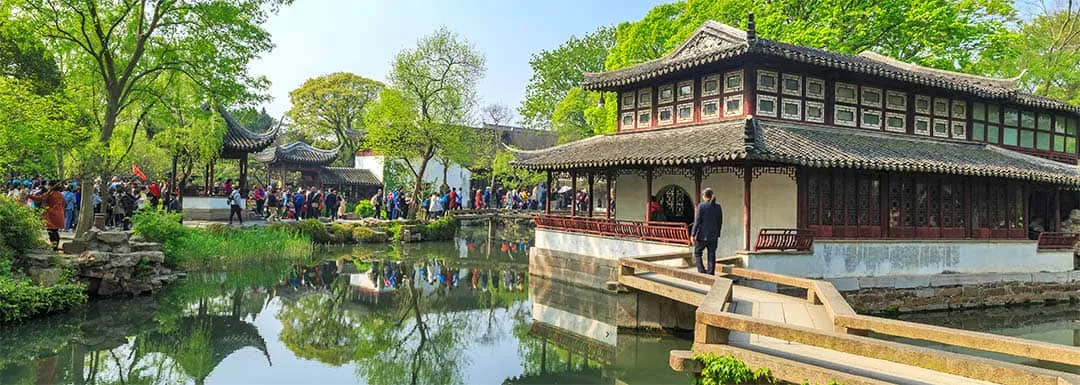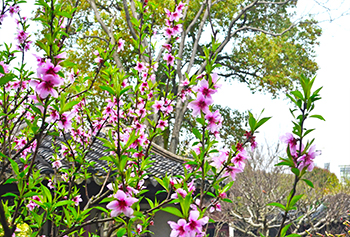Humble Administrator's Garden

Built in the early years of Zhengde of the Ming Dynasty (the early 1500s), the Humble administrator’s Garden has a history of more than 500 years. As a representative of classical gardens south of the Yangtze River, it ranks at the top of all the gardens in Suzhou. Listed as one of the first batch of major historical and cultural sites protected at the national level in 1961, it is one of four gardens – together with the Summer Palace in Beijing, Chengde Mountain Resort, and the Lingering Garden in Suzhou – which have the title of China’s Top Four Famous Gardens. In 1991, it was appraised as a National Special Scenic Spot, and in 1997 it was inscribed into the World Heritage List by UNESCO. Then in 2007 it was rated in the first batch of 5A Scenic Areas by National Tourism Administration.
Covering an area of 78 Mu (about 5.2 hectares), the Humble Administrator’s Garden is the largest classical garden in existence. Stretching around the water in its center, the garden reflects the characteristics of a water town south of the Yangtze River.
- Chinese name: 拙政园Zhuō Zhènɡ Yuán
- Duration: 2-3 hours
- Entrance fee: Low seasons (January, February, March, June, November and December): RMB 70; peak seasons (April, May, July, August, September and October): RMB 90
- Opening hours: From March 1st to November 15th: 7:30-13:30; From November 16th to February 29th: 7:30-17:00
- Best time to visit: All year round
- Address: No.178, Dongbei Street, Pingjian District, Suzhou City, Jiangsu Province.
- How to get there: 1) Take Bus 113, 115, 406, 416 (round trip), 431, 701 or 758, and get off at Sanlitun Station; 2) Take Bus 117 and get off at Changhong Bridge West Station; 3) Take bus 110, 118 (electric bus), 120, 208 (night shift), 403, 673 or 3, and get off at Beijing Workers’ Sports Complex Station
- How to get there: Take bus 1. No.40 or 313, and get off at Beiyuan Road Station; 2. No.55, 178, 202, 262, 309, 518, 529, 811 or 923, or night bus No.2, or tourist bus No.1, 2 and 5, and get off at Suzhou Museum Station.
Highlights of the Humble Administrator’s Garden
1. Architectural Style
 Lanxue Hall
Lanxue Hall The Humble Administrator’s Garden is divided into eastern, middle and western sections. Each section has its own characteristic with the eastern section being broad and spacious, the middle section being the essence of the whole garden, and the western section dotted with elegant architectural pieces.
The Humble Administrator’s Garden prides itself on its waterscape, well-proportioned courtyards, and variety flowers and plants. One major scenic spot in the garden is Lanxue Hall (‘Snow and Orchid’ Hall), the name of which comes from a poem of Libai praising Lu Zhonglian and saying that he was as pure and honest as orchid and snow. In the south of the hall stands a carved piece of lacquerware with a panoramic sketch of the Humble Administrator’s Garden on it, and the north wall of the hall is decorated with a picture of bamboo. The bonsai garden, which lies in the west of Humble Administrator’s Garden behind a wall of bamboo fence, is dubbed as a famous garden with great treasures, as the garden has nearly 10,000 bonsai of more than 50 species.
Strolling around in the Humble Administrator’s Garden, you will be amazed at the extensive and profound art of Chinese classical gardens.
In the north of the garden is the residential quarters where you can appreciate the typical layout of dwellings in the area south of the Yangtze River. The Suzhou Garden Museum also lies in the south of the garden. It is the only museum with a garden in China as its theme.
2.Rhododendron Festival and Lotus Festival
 Rhododendron Flowers
Rhododendron Flowers Rhododendron Festival: Every spring from March 28th to May 10th, the Humble Administrator’s Garden presents its annual Rhododendron Festival. The Rhododendron Festival is not only a traditional activity of the Humble Administrator’s Garden, but also has been listed as a major activity in the Suzhou Tourist Festival Project by the Suzhou government. During the Festival, diverse kinds of Rhododendron will be on display.
Lotus Festival: Every summer from early of June to the middle of October, the Humble Administrator’s Garden will have the Lotus Festival as its traditional activity. Hosted on the broad stretch of lotus pond in the Humble Administrator’s Garden, the Lotus Festival provides a platform for the gathering of hundreds of different species of lotus planted in jars and bowls, and various bonsai of aquatic plants, showing the beauty and fragrance of lotus and the freshness of summer life south of the Yangtze River. The Humble Administrator’s Garden has become the best place for tourists to appreciate lotus, and the Lotus Festival held in it has become a delight and even a new folk custom of the locals.
3. Kunqu Opera
The Peony Pavilion, written by famous Chinese playwright, Tang Xianzu, represents the best Kunqu Opera in the history of Chinese Opera. As one of the World Intangible Heritage, Kuqu Opera has influenced almost all kinds of opera in China, and can be said to have influenced the progress of Chinese Opera. If you are interested in Kunqu Opera, you can have a visit to the Humble Administrator’s Garden to appreciate the beauty of it. The tenderness, delicacy and elegance of it are sure to strike a chord with you.
Drop us a line and we'll connect you with the top China expert in no time!